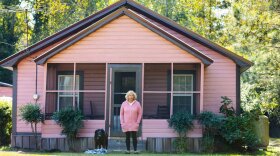As the weeks of social distancing and stay-at-home orders drag on, some people are desperate for a break from where they have been for the past couple months. Films can offer an escape and transport the viewer to faraway lands or lush landscapes.
For this month’s Movies on the Radio, host Frank Stasio and film experts Marsha Gordon and Laura Boyes share films that have a strong sense of place, from the red clay of North Carolina in “Bull Durham” to the icy landscape of Antarctica in “The Thing.” Some movies feature locations as characters, like the role of Venice in “Don’t Look Now.”
Gordon and Boyes reflect on listeners’ picks and share their own favorite place-based films. Gordon is a film professor at North Carolina State University and a fellow at the National Humanities Center. Boyes is the film curator for the North Carolina Museum of Art and the curator of the Moviediva series. Gordon’s latest documentary, “All the Possibilities” is streaming as part of the virtual River Run Film Festival until Friday, May 8.
Interview Highlights
Gordon on the importance of place in early film:
When you think about the history of film — which was really born in the 1890s — one of the initial impulses was to transport people to other places. ... Up until a couple months ago, I think we've gotten very accustomed to the idea of the ease of travel — jumping on a plane or a train or in a car and going someplace. And in the 1890s, it was more complicated. … And so it was a way to show people the world.
Boyes on place as a character in film:
A lot of times, it's inadvertent. There are so many films where the most interesting thing is that they were shooting on the streets of Los Angeles in 1948. And you get to see all of these vanished places behind the actors on screen.
Roman Holiday (1953)
https://www.youtube.com/watch?v=k3t1d4YpMSc
Boyes: I love it for its romance [and] for its location. It was the first American film that was shot entirely in Europe after World War II. And it showed such a different place than the neorealistic films that were all, you know, stolen bicycles and desperately poor people. And here was a joyous view of the city. And when we went to Italy a number of years ago, we, in fact, had one day in Rome, just like Audrey Hepburn … It's a lovely cinematic experience that we turned into a real life experience.
Gordon: Hollywood got really good at building sets, which never look like the real thing, but we kind of accept that. So the idea of seeing Rome this way, you know actual locations: Trevi Fountain, the Spanish Steps etc. I mean those are really memorable moments in film history where we shift from the artificial to the real, and the camera’s actually in the place.
The Thing (1982)
https://www.youtube.com/watch?v=5ftmr17M-a4
Gordon: It’s a place that so few of us have ever been. … The film really brokers in that, as many horror films do, but many horror films take place out on the rural country road, where you can't — once your car is disabled, you can't get back and get help from anyone in the civilized world. And so this is a lovely example, using a really well done horror film that is guaranteed — if you've never seen it before — to draw some gasps and screams.
Boyes: Claustrophobia is also a location. And it’s a location that we’re all becoming intimately familiar with, and how the isolation does allow a freedom of your mind that goes to very dark places sometimes.
Lost in Translation (2003)
https://www.youtube.com/watch?v=LSsNbFwePAE
Gordon: That arrival scene that Kurt talked about is just a wonderful expression of, first off, jet lag, which nobody likes, but which is the requirement if you’re going to travel long distances, and that bleary look at the overwhelming neon wonderland of Tokyo. It really does — just in a very poetic, not-too-long opening sequence — immerse you in the physical aspects of Tokyo through that moment of entering the city.
Boyes: I would classify this also as a kind of anti-travel film, because I’m not sure that the loneliness and the alienation and the overwhelming culture shock the two lead characters feel — it does really evoke the sensation of traveling to such unfamiliar places. But there's no real joy in this film.












